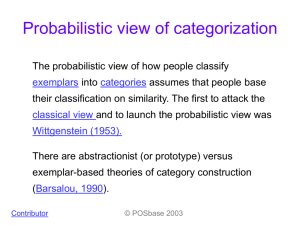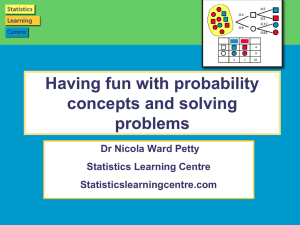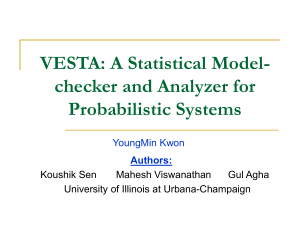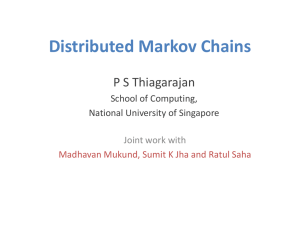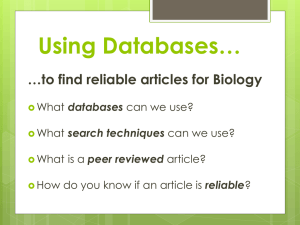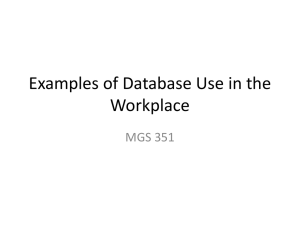Applications
advertisement
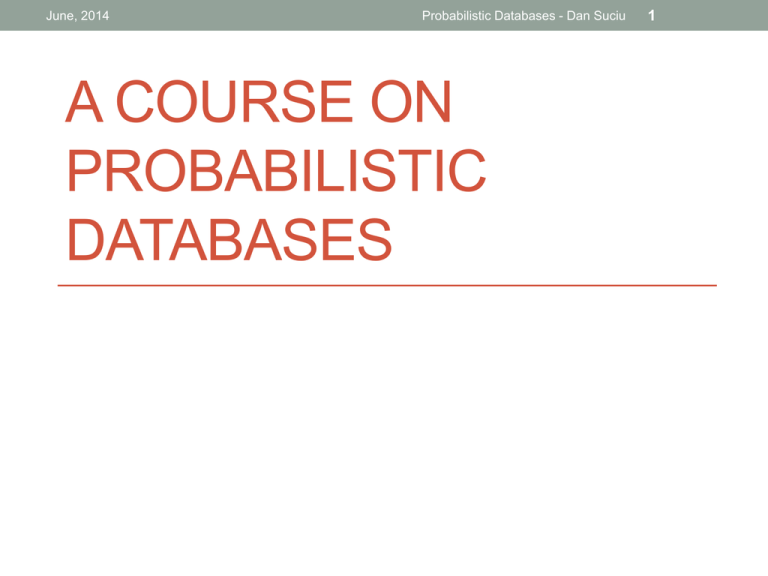
June, 2014 Probabilistic Databases - Dan Suciu A COURSE ON PROBABILISTIC DATABASES 1 June, 2014 Probabilistic Databases - Dan Suciu 2 Probabilistic Databases • Data: standard relational data, plus probabilities that measure the degree of uncertainty • Queries: standard SQL queries, whose answers are annotated with output probabilities June, 2014 Probabilistic Databases - Dan Suciu 3 A Little History of Probabilistic DBs Recent work Early days • Wong’82 • Stanford (Trio) • Shoshani’82 • UW (MystiQ) • Cavallo&Pittarelli’87 • Barbara’92 • Cornell (MayBMS) • Oxford (MayBMS) • U.of Maryland • Lakshmanan’97,’01 • IBM Almaden (MCDB) • Fuhr&Roellke’97 • Rice (MCDB) • Zimanyi’97 • U. of Waterloo • UBC • U. of Florida Main challenge: Query Evaluation (=Probabilistic Inference) • Purdue University • U. of Wisconsin June, 2014 Probabilistic Databases - Dan Suciu Why? Many applications need to manage uncertain data • Information extraction • Knowledge representation • Fuzzy matching • Business intelligence • Data integration • Scientific data management • Data anonymization 4 June, 2014 Probabilistic Databases - Dan Suciu 5 What? • Probabilistic Databases extend Relational Databases with probabilities • Combine Formal Logic with Probabilistic Inference • Requires a new thinking for both databases and probabilistic inference June, 2014 Probabilistic Databases - Dan Suciu This Course: Query Evaluation Based on the book: 6 June, 2014 Probabilistic Databases - Dan Suciu 7 Part 1 Motivating Applications 2. The Probabilistic Data Model Chapter 2 3. Extensional Query Plans Chapter 4.2 4. The Complexity of Query Evaluation Chapter 3 5. Extensional Evaluation Chapter 4.1 6. Intensional Evaluation Chapter 5 7. Conclusions Part 4 Part 3 1. Part 2 Outline of the Tutorial June, 2014 Probabilistic Databases - Dan Suciu What You Will Learn • Background: • Relational data model: tables, queries, relational algebra • PTIME, NP, #P • Model counting: DPLL, OBDD, FBDD, d-DNNF • In detail: • Extensional plans, extensional evaluation, running them in postgres • The landscape of query complexity: from PTIME to #P-complete, • Query compilation: Read-Once Formulas, OBDD, FBDD, d-DNNF • Less detail: • The #P-hardness proof, complexity of BDDs • Omitted: • Richer data models: BID, GM, XML, continuous random values) • Approximate query evaluation, • Ranking query answers 8 June, 2014 Probabilistic Databases - Dan Suciu 9 Related Work. See book, plus: These references are not in the book The applications are from: • Wegener: Branching programs and binary • Ré, Letchner, Balazinska, S: Event queries decision diagrams: theory and applications, 2000 • Dalvi, S.: The dichotomy of probabilistic inference for unions of conjunctive queries, JACM’2012 • Huang, Darwiche: DPLL with a Trace: From on correlated probabilistic streams. SIGMOD Conference 2008 • Gupta, Sarawagi: Creating Probabilistic Databases from Information Extraction Models. VLDB 2006 • Stoyanovich, Davidson, Milo, Tannen: SAT to Knowledge Compilation, IJCAI 2005 Deriving probabilistic databases with inference ensembles. ICDE 2011 • Beame, Li, Roy, S.: Lower Bounds for • Beskales, Soliman, Ilyas, Ben-David: Exact Model Counting and Applications in Probabilistic Databases, UAI’13 • Gatterbauer, S.: Oblivious Bounds on the Probability of Boolean Functions, under review Modeling and Querying Possible Repairs in Duplicate Detection. PVLDB 2009 • Kumar, Ré: Probabilistic Management of OCR Data using an RDBMS. PVLDB 2011 June, 2014 Probabilistic Databases - Dan Suciu A COURSE ON PROBABILISTIC DATABASES Lecture 1: Motivating Applications 10 June, 2014 Probabilistic Databases - Dan Suciu 11 Part 1 Motivating Applications 2. The Probabilistic Data Model Chapter 2 3. Extensional Query Plans Chapter 4.2 4. The Complexity of Query Evaluation Chapter 3 5. Extensional Evaluation Chapter 4.1 6. Intensional Evaluation Chapter 5 7. Conclusions Part 4 Part 3 1. Part 2 Outline June, 2014 Probabilistic Databases - Dan Suciu 12 [Gupta’2006] Example 1: Information Extraction 52-A Goregaon West Mumbai 400 076 CRF Standard DB: keep the most likely extraction Probabilistic DB: keep most/all extractions to increase recall Key finding: the probabilities given by CRFs correlate well with the precision of the extraction. June, 2014 Probabilistic Databases - Dan Suciu 13 [Stoyanovich’2011] Example 2: Modeling Missing Data Standard DB: NULL Probabilistic DB: distribution on possible values Key technique: Meta Rule Semi-Lattice for inferring missing attributes. June, 2014 Probabilistic Databases - Dan Suciu 14 [Beskales’2009] Example 3: Data Cleaning Standard DB cleaning data means choosing one possible repair Challenge: Representing multiple repairs. [Beskaes’2009] restrict to hierarchical repairs. Probabilistic DB keep many/all possible repairs June, 2014 Probabilistic Databases - Dan Suciu 15 [Kumar’2011] Example 4: OCR They use OCRopus from Google Books: output is a stohastic automaton Traditionally: retain only the Maximum Apriori Estimate (MAP) With a probabilistic database: may retain several alternative recognitions: increase recal SELECT DocId, Loss FROM Claims WHERE Year = 2010 AND DocData LIKE '%Ford%’; June, 2014 Probabilistic Databases - Dan Suciu 16 Summary of Applications • Structured, but uncertain data • Modeled as probabilistic data • Answers to SQL queries annotated with probabilities Probabilistic database: • Combine data management with probabilistic inference
